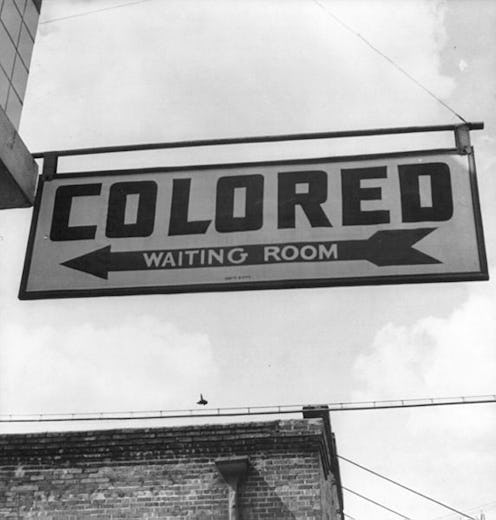Life
America's Dark History Of Bathroom Discrimination
As you've no doubt already heard, the Trump administration has officially revoked the Obama-era guidance that allowed transgender students to use the school bathroom that fits their gender identity. Though the Obama administration had tied their guidance to Title IX — the federal law that bans sex discrimination in schools — the Trump administration's letter claimed that it was removing the guidance "in order to further and more completely consider the legal issues involved."
This development is much more than just a massive blow for transgender kids who just want to use the bathroom and attend school in peace. It is also, of course, a new chapter in the ongoing war on transgender rights in the U.S. — a war which has frequently involved claims that allowing people to use the public bathroom that aligns with their gender identity would somehow open the door to violence and "sexual predation" (despite the fact that that myth has been totally debunked and, as National Center for Transgender Equality director of communications Vincent Villano told Mic, the NCTE has "not heard of a single instance of a transgender person harassing a non-transgender person in a public restroom.")
But this policy is also part of a larger history of discrimination, throughout the U.S. and beyond. While sometimes the universality of the need for hygiene was used to show that we're all human — the 16th century French philosopher Michel Montaigne, for instance, famously said "Kings and philosophers sh*t, and so do ladies" — more often it was either tightly regulated or implicitly seen along lines of difference.
Throughout history, restrooms have been regulated for the sake of "public morality" — in ancient Rome, they were viewed as "notorious trysting-places," subject to strict sets of rules, and and occasionally closed down for their potential for "immoral" behavior — and these rules have consistently provided a window into each era's prejudices.
In The US, Hygiene & Class Have Always Been Tied
To understand how hygiene and class (and, of course, race) intersect in American history, you've got to understand the progression of the bathroom itself. For centuries, bathrooms were a marker of class; the top echelons of people from medieval Europe onwards, for instance, had a private bathroom (or garderobe), while the middle and lower classes resorted to chamber pots that would then be emptied into streets, or to public toilets (often called "pissyngholes") erected over bridges or running water. Privies, as they were called, were a matter of social status and wealth, and where you "did your business" reflected who you were in the eyes of society.
You find the same basic ideas about cleanliness reflected in American culture in the 1850s, an era in which the American Medical Association advocated for public baths for those who couldn't afford private bathrooms (which were then quite uncommon). The AMA argued that people needed access to baths for their "moral as well as physical improvement." Dirt, then as now, had a strong moral and class dimension; to not have a bathroom or be unable to get clean reflected on your social standing and moral fiber.
It was also a societal belief that the upper classes had to monitor the cleanliness of the lower ones. Washing, according to the home manuals of the late 19th and early 20th century, was a mark of "gentility" and social etiquette, and the middle classes used their cleanliness as a form social mobility. It was with private bathrooms, though, that the idea of gender and race segregation really came to the fore.
Bathrooms Were Used As A Tool Of Racial Segregation
As Slate has pointed out, attempting to regulate which person goes into which toilet in order to avoid supposed "dangers" has strong parallels to the practice of segregating bathrooms by race, which was enforced in the U.S. during the "Jim Crow" era. Civil rights advocate Kimberle Crenshaw explains that America's racial system "held that blacks were less than fully human [and] also dirty and impure. Racially segregated bathrooms ensured that blacks would not contaminate the facilities used by whites."
The argument for racially segregated bathrooms was all about imagined cleanliness and "threats": for example, Tennessee segregated bathrooms on the grounds that black patrons would spread STDs to white ones through bathroom equipment (which, of course, is not how STDs are spread). This line of thinking closely echoes fears that allowing transgender people to use the bathroom consistent with their gender identity would somehow created a "danger" to cisgender people.
Gay Men Were Once Considered "Dangerous" In Public Bathrooms
The idea that bathrooms somehow become sites of fear and possible sexual assault the second they involve anyone who is not a cisgender heterosexual is tied to something else in American culture: homophobia. "Perhaps the most obvious example of homophobic panic," writes Sheila Cavanagh in Queering Bathrooms: Gender, Sexuality, and the Hygienic Imagination, "is to be seen in the alacrity with which police entrap and arrest gay men in toilets." The policing of toilets in the 1980s and '90s in America was hugely concerned with the idea of controlling gay cruising, as it was viewed by some as an "affront to public decency" — and, therefore, needed to be illegal.
Gay men were performing acts viewed by the culture's self-appointed moral arbiters as "disgusting" and "offensive" in bathroom spaces, and were targeted for it; and that homophobic prejudice remains, helping fuel the false idea of the transgender sexual predator.
What do transgender people do in bathrooms? Well, they just want to use the toilet, splash some water on their faces, fix their hair, and steal away a moment to play Candy Crush like anyone else. But in yet another entry in the long history of bathrooms as cultural battlegrounds, transphobic legislation seeks to flush these basic human rights straight down the toilet .
